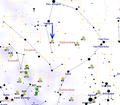| Messier 14 | |
|---|---|
 Globular cluster Messier 14 in Ophiuchus Globular cluster Messier 14 in Ophiuchus | |
| Observation data (J2000 epoch) | |
| Class | VIII |
| Constellation | Ophiuchus |
| Right ascension | 17 37 36.15 |
| Declination | –03° 14′ 45.3″ |
| Distance | 30.3 kly (9.3 kpc) |
| Apparent magnitude (V) | 7.6 |
| Apparent dimensions (V) | 11.0′ |
| Physical characteristics | |
| Mass | 1.04×10 M☉ |
| Radius | 50 ly |
| Metallicity | = –1.28 dex |
| Other designations | NGC 6402 |
| See also: Globular cluster, List of globular clusters | |
Messier 14 (also known as M14 or NGC 6402) is a globular cluster of stars in the constellation Ophiuchus. It was discovered by Charles Messier in 1764.
At a distance of about 30,000 light-years, M14 contains several hundred thousand stars. At an apparent magnitude of +7.6 it can be easily observed with binoculars. Medium-sized telescopes will show some hint of the individual stars of which the brightest is of magnitude +14.
The total luminosity of M14 is in the order of 400,000 times that of the Sun corresponding to an absolute magnitude of -9.12. The shape of the cluster is decidedly elongated. M14 is about 100 light-years across.
A total of 70 variable stars are known in M14, many of the W Virginis variety common in globular clusters. In 1938, a nova appeared, although this was not discovered until photographic plates from that time were studied in 1964. It is estimated that the nova reached a maximum brightness of magnitude +9.2, over five times brighter than the brightest 'normal' star in the cluster.
Slightly over 3° southwest of M14 lies the faint globular cluster NGC 6366.
Gallery
See also
References
- Shapley, Harlow; Sawyer, Helen B. (August 1927), "A Classification of Globular Clusters", Harvard College Observatory Bulletin, 849 (849): 11–14, Bibcode:1927BHarO.849...11S.
- ^ "NGC 6402". SIMBAD. Centre de données astronomiques de Strasbourg. Retrieved 2006-11-15.
- ^ Boyles, J.; et al. (November 2011), "Young Radio Pulsars in Galactic Globular Clusters", The Astrophysical Journal, 742 (1): 51, arXiv:1108.4402, Bibcode:2011ApJ...742...51B, doi:10.1088/0004-637X/742/1/51, S2CID 118649860.
- "Messier 14". SEDS Messier Catalog. Retrieved 21 July 2024.
- distance × sin( diameter_angle / 2 ) = 50 ly radius
- "Messier 14 | Messier Objects". 31 March 2015. Retrieved 2020-04-14.
External links
- SEDS Messier pages on M14
- M14, Galactic Globular Clusters Database page
- NASA Astronomy Picture of the Day: The Comet and the Star Cluster (11 April 2016) - one of the two being M14
- Messier 14 on WikiSky: DSS2, SDSS, GALEX, IRAS, Hydrogen α, X-Ray, Astrophoto, Sky Map, Articles and images
| Astronomical catalogs | |
|---|---|
| Messier | |
| NGC | |
| Messier objects | ||
|---|---|---|
| List |
|  |
| See also | ||
 = –1.28
= –1.28 
